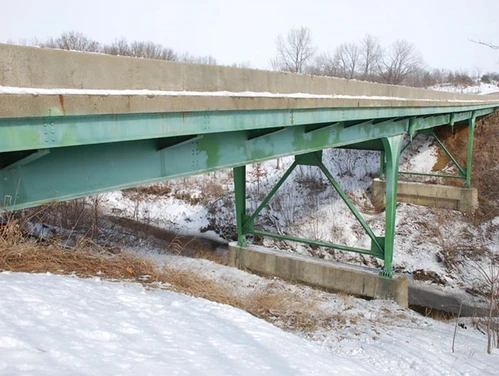- Year constructed: 1950
- Bridge type: Rigid Continuous Steel Frame
- National Register of Historic Places status: Eligible
- Length: 182 feet
- Width: 26 feet
- Spans: 3
- FHWA: 013870
- Jurisdiction: Iowa DOT
- Location: Iowa 5 over Little Shoal Creek southwest of Cincinnati, Section 8, T67N-R18W (Pleasant Township)
Details
The bridge was built in 1950 to replace a 42' x 15' wood bridge. The channel of the creek was moved to the east and this new bridge was built. The bridge consists of two 55' end spans and a 70' center span and features a continuous I-Beam superstructure and a riveted steel pier leg substructure. The tapered steel legs measure over 18' from the I-beams to the concrete piers. The open steel rails have been replaced with solid concrete. The deck was also resurfaced in 1988. The bridge was designed by the ISHC in April 1948.
In 1949, relocation of Iowa Highway 5 north of Cincinnati was underway. In February 1950, the ISHC was working with the Missouri State Highway Commission on the relocation of the highway to the Missouri state line. No details were found on the highway or bridge's construction. However, an article on a newly finished roadside park on the "new highway" in the November 29, 1950 issue of the Centerville Daily Iowegian indicated that the highway was completed by that time (Centerville Daily Iowegian November 29, 1950:3).
This steel continuous rigid frame bridge is an early example of its type that was rarely used in Iowa. The simplest form of rigid frame bridge consists of a horizontal beam or girder span supported by legs (piers) at each end to which the beam is rigidly connected. Rigid frame bridges are continuous structures that have been called a hybrid of the arch and girder bridge because some of the vertical moments on the deck become horizontal thrusts in the legs that must be restrained by the abutments or leg foundations. The Steel Continuous Rigid Frame bridge (Type 407) is generally used for short spans such as highway overpasses and usually are one span and seldom consists of more than two spans. The Steel Continuous Rigid Frame bridge was considered costly and less practical than the concrete version and found little use for highways until the development of the slant-leg continuous steel rigid frame bridge in the 1960s. By the 1960s steel prices had eased while labor costs continued to rise, making steel bridges that could be quickly erected in any weather popular for overpasses on time sensitive limited-access highway projects.
The Iowa Highway 5 Bridge meets meets registration requirements outlined in the MPD, Highway Bridges in Iowa: 1942-1970 and as such is eligible for inclusion in the NRHP under Criterion C. The bridge is a early well-preserved example of a steel continuous rigid frame bridge that was rarely used in Iowa. The bridge is also significant as it is a multi-span bridge, which is rarely seen in this bridge type. The bridge has a high degree of integrity with only deck resurfacing and handrail replacement.
Areas Served
- Appanoose
